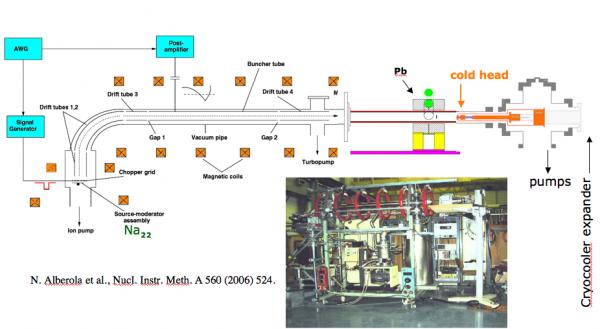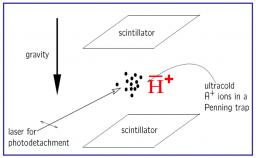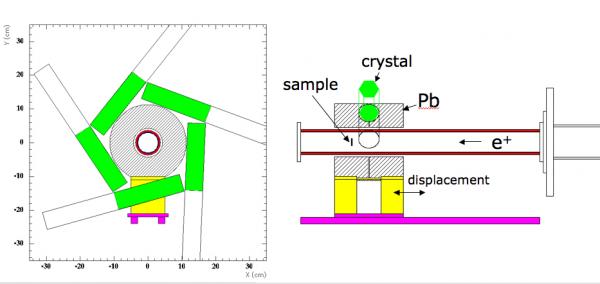Aims:
One of the fundamental questions of today’s physics concerns the action of gravity upon antimatter. No experimental direct measurement has ever been successfully performed with antimatter particles. CERN has thus launched a research program with the Antiproton Decelerator (AD) allowing to prepare a measurement of the effect of gravity on antihydrogen atoms.
The primary aim of this experiment is to determine how antimatter reacts to gravity. A first test will be to verify the sign of the gravitational acceleration for antimatter, as a theory opens the possibility for it to be negative, which would translate as an elevation rather than a fall of an antimatter atom only submitted to the gravity force of the Earth. Other theories predicting less spectacular deviations with respect to standard gravitation will also be tested.
The GBAR project, initiated by an IRFU team, has been approved by CERN in May 2012. It started as a R&D program of IRFU demonstrating the feasibility of an intense beam of slow positrons. This beam is needed to create a target of positronium atoms (the bound state of an electron and a positron), allowing the production of H+ ions when bombarded with antiprotons.
Several challenges must be overcome, with the following ones being studied in IRFU:
- Create a slow positron source of high intensity (108/s) ; the usual radioactive sources uses to make antihydrogen are limited at about 106/s.
- Create positronium atoms with density of order 1012 cm-2, using a mesoporous silica substrate;
- Exploit these in a very short time, of order their decay time period of 142 ns, with the aim to form a target for the antiprotons.
It will then be possible to create neutral anti-hydrogen H as well as positive anti-hydrogen ions H+. Note that if protons are used as incident particles instead of antiprotons, one obtains hydrogen and H- ions.
Competing Experiments
ALPHA-g (Antihydrogen Laser PHysics Apparatus)
AEGIS (Antimatter Experiment: Gravity, Interferometry, Spectroscopy)
Location
-The GBAR experiment started its installation in the CERN AD hall in December 2016. It will be connected to the new deceleration ring ELENA recently build in the AD hall
-The SOPHI and SELMA projects are located in the CEA-Saclay site (former Saturne accelerator Hall). The SOPHI facility received an ANR grant and is the prototype of the positron source built by GBAR at CERN. SELMA is the small linear electron accelerator feeding the source. Another ANR grant supported the ANTION project, devoted to study the interaction between protons and positronium. It will measure the production of hydrogen atoms at Saclay, then later at CERN the production of H- ions, then of antihydrogen and of H+ ions.
Contribution of IRFU
IRFU initiated this project.
It studies and builds an intense beam of positrons based on a small electron linear accelerator.
It studies the trapping ond storage of the positrons;
It studies the production of positronium with positrons, and the interactions of protons/antiprotons with the positronium.
Size of the project
GBAR is a collaboration of 19 institutes in 9 countries
The IRFU team received funding from IRFU, the French National research Agency (ANR) (for SOPHI, POSITRAP and ANTION projects) and from the district of Essonne (for the SELMA project).
This project has a human size compared to the big CERN experiments; it is highly multidisciplinary, dealing with particle physics, atomic physics, accelerator physics, laser…
The goal, ambitious and complex, is fundamental for physics, because any deviation of the antimatter gravity compared to the matter one would lead to revisit the classical models at the most fundamental level.
Contacts
Publications
-
The GBAR experiment: gravitational behaviour of antihydrogen at rest
P. Pérez and Y. Sacquin, Class. Quantum Grav. 29 (2012) 184008. -
Positron annihilation in latex templated macroporous silica films: pore size and ortho-positronium escape
L. Liszkay et al., New Journal of Physics 14 (2012) 065009. -
Muonium emission into vacuum from mesoporous thin films at cryogenic temperatures
A. Antognini et al., Phys. Rev. Lett. 108, 143401 (2012). -
Etude et réalisation d’un faisceau de positons lents
N. Ruiz, Université Pierre et Marie Curie, Paris, France (2011). -
Proposal to measure the Gravitational Behaviour of Antihydrogen at Rest
P. Pérez et al., CERN-SPSC-P-342, 30/09/2011. -
Piégeage de positons dans un piège de Penning Malmberg, en vue de leur accumulation avec un faisceau pulsé
P. Dupré, Université Pierre et Marie Curie, Paris, France (2011). -
GBAR, Gravitational behavior of antihydrogen at rest.
P. Debu et al., Hyp. Int. 199 , xxx (2011). -
Measurement of the ortho-positronium confinement energy in mesoporous thin films
P. Crivelli et al., Phys. Rev. A 81 , 052703 (2010). -
Positronium Cooling in Porous Silica Measured via Doppler Spectroscopy
D. B.. Cassidy et al., Phys. Rev. A 81, 012715 (2010). -
A mini linac based positron source
P. Pérez et al., Phys. Status Solidi C 6, 2462 (2009). -
Mesoporous silica films with varying porous volume fraction: Direct correlation between ortho-positronium annihilation decay and escape yield into vacuum
L. Liszkay et al., Appl. Phys. Lett. 95, 124103 (2009). -
Ortho-positronium reemission yield and energy in surfactant-templated mesoporous silica films
L. Liszkay et al., Materials Science Forum 607, 30-33 (2009). -
Positronium reemission yield from mesostructured silica films
L. Liszkay et al., Appl. Phys. Lett. 92, 063114 (2008). -
A High Intensity Positron Source at Saclay: the SOPHI Project
J-M. Rey et al., AIP Conf. Proc. 1099, Fort Worth (Texas), 2008, p944-947. -
A Scheme To Produce The Antihydrogen Ion Hbar+ For Gravity Measurements
P. Pérez et al., AIP Conf. Proc. 1037, Okinawa (Japan), 2008, ed. Y. Kanai and Y. Yamazaki, p35-42. -
A Scheme to Produce a Dense Positronium Plasma for an Antihydrogen Experiment
P. Pérez et al., Appl. Surf. Sci. 255, 33-34 (2008). -
Orthopositronium annihilation and emission in mesostructured thin silica and silicalite-1 films
L. Liszkay et al., Appl. Surf. Sci. 255, 187-190 (2008). -
Letter of Intent to the CERN-SPSC
P. Pérez et al., CERN-SPSC-2007-038 (2007). -
A New Path Towards Gravity Experiments with Antihydrogen
P. Pérez and A. Rosowsky, AIP Conf. Proc. 793, Wako (Japan), 14-16 March 2005, ed. Y. Yamazaki, M. Wada, p165-168. -
Intense Source of Slow Positrons
P. Pérez and A. Rosowsky, AIP Conf. Proc. 793, Wako (Japan), 14-16 March 2005, ed. Y. Yamazaki, M. Wada, p 347-350. -
A new path toward gravity experiments with antihydrogen
P. Pérez and A. Rosowsky, Nucl. Instr. Meth. A 545, 20-30 (2005). -
Intense source of slow positrons
P. Pérez and A. Rosowsky, Nucl. Instr. Meth. A 532, 523-532 (2004).
Patents
Principle of the experiment
A way to produce antihydrogen atoms which allows to measure their fall in the gravity field of the Earth has been studied in DAPNIA/SPP [1]. The path proposed will produce positively charged antihydrogen ions (H+), much easier to manipulate than the neutral atoms (H). This allows to slow them down enough to perform the gravitational measurement.
This path consists in the chain of reactions opposite. The antiprotons (p) interact with positronium (Ps) in order to produce atoms of antihydrogen in their fundamental state. The neutral atoms thus formed interact again with Ps to produce the positively charged ion. The target for the antiprotons is then a dense gas of positronium atoms, instead of the cloud of positrons currently used in the antihydrogenexperiments at CERN. The neutral antihydrogen atoms produced in the first reaction, with a rate 1000 times higher, may also be sued for other types of experiments.
Note that positronium may be excited with a laser system in order to control the distribution of excitation levels ( quantum number n). The excited antihydrogen atoms are then produced with a much higher cross section, proportional to n4.
An example of an experiment was proposed where these H+ ions may be slowed down to a velocity of order 1 m/s [*]. Their extra positron is expelled via a laser excitation which produces the energy necessary to detach them. Their low velocity allows to measure the gravity acceleration of these atoms made of antimatter over a distance of a few centimetres compatiblewith an apparatus of reasonable size.
* J.Walz & T. Hänsch, General Relativity and Gravitation, 36 (2004) 561.
Overall scheme
In order to reach the final goal of the experiment, we must combine several elements coming each from a separate discipline in experimental physics. The production of positrons in large numbers will be obtained using an electron accelerator (see the SELMA and SOPHI projects). The storage of the produced positrons will be performed with a Penning-Malmberg trap as developed by C. Surko in San Diego or A. Mohri in Japan. They will then be extracted from this trap and dumped onto a material, with good properties to convert positrons into positronium, in a few tens of ns. The antiprotons coming from the AD at CERN are stored in a trap, such as the one developed by the ASACUSA collaboration, and extracted as a beam of a few KeV traversing the dense positronium cloud. The H+ ions thus formed are transported down to an atomic trap containing a low density of Be+ ions which slow them down to velocities of order 1 m/s. The H+ ions are then neutralised when their extra positron is photo-detached with a two-photon process in order to give no momentum along the vertical direction. The atoms then neutral fall on a scintillator where they annihilate, producing an energy large enough to provide their arrival time t2 on this scintillator. The distance dx between the horizontal laser beam and trigger time t1 of the laser beam being known, the value of the gravitational acceleration g on these antihydrogen atoms is given by the famous formula dx = 1/2 g (t2-t1)2.
Research Means
The AD/ELENA beam will provide approximately 6 106 antiprotons of 100 KeV per bunch every 110 s. These antiprotons will be transported to and traverse a dense target of positronium atoms (around 1012 cm-2). While going through this target, the antihydrogen atoms and the H+ ions are formed. We estimate that 1 to 10 ions are formed per pulse of 107 antiprotons. Around 1000 neutral atoms are also formed in the fundamental state.
In order to create the positronium target, 1010 positrons are dumped onto a material which converts them into positronium within a few tens of nanoseconds. These time spans take into account the time it takes to dump the antiprotons as well as the lifetime of positronium of 142 ns (triplet state). The fast extraction from the trap has been checked with the MRT trap in the RIKEN laboratory.

Sketch of the slow positron beam line of ETH Zurich at CERN. The TOF and cryocooler are visible at the right end.
e+ to Ps converters
Materials able to convert positrons into positronium are prepared in Nancy, Mulhouse, Ecole Polytechnique or Saclay. Materials with the highest conversion efficiency are selected as checked firstly at CERI (Orléans) where the production rate of ortho-positronium (oPs), the triplet state with a long lifetime (142 ns), is measured. We also select those materials emitting in vacuum oPs atoms with the lowest possible velocity. This is achieved by placing samples in the slow positron beam of ETH Zurich at CERN. A time of flight measurement system has been added in order to determine the velocity of the emitted positronium atoms. A sample holder coupled to a cryocooler and a heater allows to study the performances of these materials as a function of temperature (10-600K). A lifetime measurement system completes this set in order to improve the estimate of the fraction of oPs produced.
Time of Flight measurement of oPs
Five BGO counters surround a lead cylinder cut in two halves by a variable width slit. The lead is placed around the vacuum beam pipe. Slow positrons (1-5 KeV) are implanted into the sample to be studied. The oPs which is emitted into vacuum flies back until it decays emitting 3 photons whose energy sum 1.022 MeV. When one of these photons passes through the slitto reach one of the counters, its energy, as well as its arrival time, are registered. The distance between the slit and the sample is known. The time when the positron hits the sample is given by secomndary electrons emitted during the interaction between the incident positron and the sample. These electrons are detected with an MCP (Multi Channel Plate). The set of counters and lead can be moved with respect to the sample along the beam axis.
Spécificity
Our specificity consists in using the H+ ion in the following two reactions.
Activities underway:
GBAR International Collaboration :
- CEA/IRFU - Saclay (France)
- CEA/IRAMIS - Saclay (France)
- CNRS/CSNSM - Orsay (France)
- ETH - Zurich (Switzerland)
- ILL - Grenoble (France)
- IPCMS - Strasbourg (France)
- JGU - Mainz (Germany)
- Lebedev - Moscow (Russia)
- LKB - Paris (France)
- NCBJ - Otvock (Poland)
- RIKEN -Wako (Japan)
- U. of Swansea (UK)
- U. of Tokyo - Komaba (Japan)
- Tokyo U. of Science (Japan)
- U. of Uppsala (Sweden)
Detail of french collaborations :
- CNRS/CSNSM, Orsay (D. Lunney, P. Dupré)
- LKB, Paris (P. Indelicato, F. Biraben, L. Hilico, et al.)
- IPCMS, Strasbourg (P-A. Hervieux, G. Manfredi)
- CEA/DSM/IRAMIS/LSI (C. Corbel)
- CNRS/CEMHTI, Orléans, M-F. Barthe.
- LCPME, UMR-7564, CNRS (Nancy)
- LMPC, UMR-7016, CNRS (Mulhouse)
Detail of bi-lateral international collaborations :
- ETH Zurich (André Rubbia and Paolo Crivelli)
- RIKEN, Wako Japan (Y. Yamazaki, A. Mohri)
- AIST, Tsukuba, Japan (R. Suzuki, N. Oshima)
History and main events
9/12/2004: The scientific comittee of Dapnia (Irfu) /SPP approves an R&D programme on methods leading to the production of antihydrogen using positronium.
15/04/2005: French Patent N° 2 852 480
11/2005: demonstration of the extraction of more than 1010 electrons from a Penning trap in less than 75 ns. This test was performed at the Atomic Physics Laboratory of RIKEN (Wako, Japan).
03/2008: SOPHI hardware arrived at the lab.
05/2008: A nanoporous SiO2 material converts 35% of incoming 2 keV e+ into o-Ps (with ETHZ, Orléans (CEMHTI), and Tsukuba-AIST).
Perspectives
Connection between slow positron beam line and RIKEN trap (March 2012)
Accumulation of positrons (2012)
Creation of target positronium downstream of trap (2013)
Excitation of Ps target with lasers (2014)
In November 2006, an ASTRE candidature was presented to the "Conseil Général de l’Essonne" and accepted under the name SELMA. This allowed to purchase a small electron linear accelerator based on a magnetron as RF source.
A positron source based on the principle of such a small accelerator of low energy has the advantage not to be classified as a nuclear installation (INB). Such systems indeed exist which are based on nuclear research reactors to produce positrons, as in Garching (Germany) in the FRMII reactor (NEPOMUC) or else with the reactor in TU Delft (Netherlands). More compact than these systems, it could produce a competitive rate of slow positrons depending on the electron intensity.
The energy was measured to be 4.3 MeV with an intensity of 0.13 mA. The positron rate produced with such a machine is ~ 1.5 1010 s-1. The antimatter gravity experiment at CERN will need a more powerful linac. However, the present machine allows testing a large part of the components of this experiment: slow positron production and accumulation in a Penning trap, creation of a positronium traget and excitation of these positroniums.

Collecting the positrons created in the tungsten target is obtained with the help of coils producing a field of around 0,2 T. the selection between e- and e+ is performed with coils arranged in the form of a magnetic dipole.
The project to measure the gravitational acceleration of antihydrogen atoms requires the production of a dense target of positronium atoms, the e+e- bound state with a lifetime in the triplet state of 142 ns. A large amount of "slow" positrons (energy range from eV to a few keV) is necessary. Radioactive sources based on 22Na are not intense enough. Moreover, the efficiency of the moderation process, which allows to slow down the positrons, must be taken into account . It varies from 10-5 to 10-2 according to the moderator type which can be used in the experimental environment. The possibility to produce positrons of low energy with an accelerator has thus been studied [2]. The process employed is pair creation from an electron beam hitting a target of high Z. For such an experiment, a dedicated beam is necessary. The price of accelerators led us to study the performances of an accelerator of very low energy (< 10 MeV) compensating the low cross section by increasing the intensity of electrons, this being limited by how the target sustains heating for an intensity of order 1 mA. This study resulted in a patent [3].
The ANR funded project SOPHI consists in a selector between electrons from the primary beam and the positrons emitted by a tungsten target at low incidence angle [2]. This selection opens the possibility to use a moderator with solid Neon to slow down efficiently the positrons from MeV to eV energies, rather than a tungsten moderator roughly 100 times less efficient. Indeed, the temperature of solid Neon at 7K does not allow to place this type of moderator in the direct environment of the electron beam which has a power of order kW.
The set comprising the target, the vacuum vessel, the coils, as well as the positron detector, was built in IRFU and by the company SigmaPhi. Delivery was performed during spring 2008
• The ultimate constituents of matter › Fundamental Interactions: tests at low energies Structure and evolution of the Universe
• Accelerators, Cryogenics and Magnetism Division (DACM) • The Particle Physics Division










